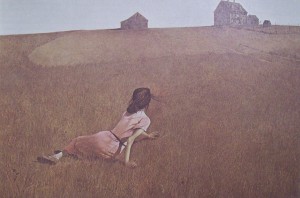
When you consider some of the really good artists and their works, you often wonder what they have in common. In many cases, an art critic might point out that it is the ability to simplify their subject. This, of course, is not entirely true, but there is a tendency to do this, as if they work hard at it.
Ask yourself this: do you paint what you are seeing? Or do you paint what you want your viewers to see? If you do the latter, then it takes careful planning of the composition. This means simplifying what you are seeing, unless the scene you are seeing is already void of anything but only the necessary ingredients for the perfect picture. Does that tree grow too close to the house? Should it be moved to a more picturesque location? or should it be removed from the scene entirely? I think you’re beginning to get the picture…right?

I’ve always enjoyed studying the works of artist. Two of my favorites are Andrew Wyeth and Robert Vickrey. They both were masters at the egg tempera technique, which is complicated enough, but they often painted pictures with a great many details. However, they manged to simplify their compositions by allowing only the details to remain that mattered.
For example, when painting Christina’s World, Wyeth worked months painting the hill of brown grass (which takes up the majority of the space on the canvas). Christina (the subject of the painting) is in the field. The Olson farm is in the distance, and is painted in a manner not to compete with the subject. There it is…one, two, three. A big space of grass, a person alone in the field, and a farm house and barn in the distance. It’s simple…right? Perhaps simple, but a lot of hard work.
If you study the beautiful and intricate works of Robert Vickrey, you see the effort he expended to simplify very complicated compositions, allowing only the bare necessary details to create the picture. An example of this is seen in the painting used as the cover of his book: Robert Vickrey~Artist at Work.
The illustrations depicted on this page are intended for educational purposes only. They are low resolution photographs that can not possibly represent their true value or worth.
Be sure to join our newsletter (upper right).
